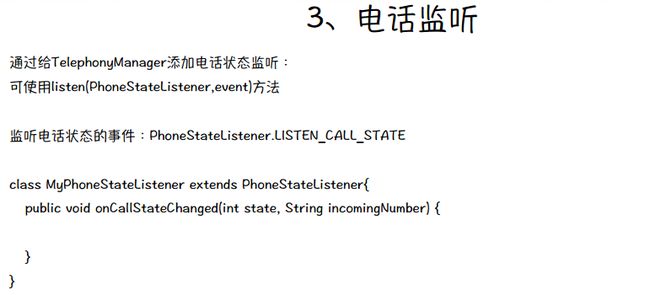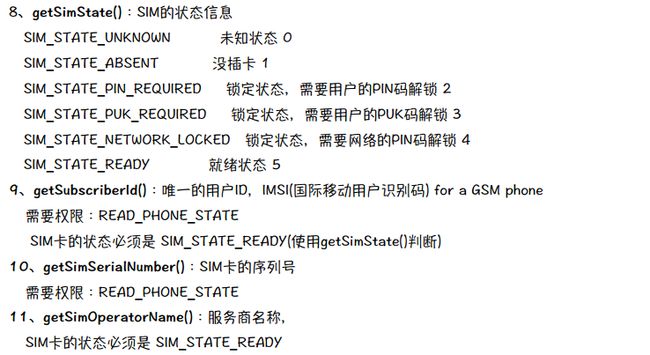扣丁学堂——TelephoneManager
一丶代码见本文
二丶课程讲解
下面代码简单输出一下手机状态:
权限:
<uses-permission android:name="android.permission.READ_PHONE_STATE" />
//电话服务管理的API方法
public void testTelePhoneManager() {
TelephonyManager tm = (TelephonyManager) getSystemService(Context.TELEPHONY_SERVICE);
System.out.print("电话状态:" + tm.getCallState());
System.out.print("唯一的设备ID:" + tm.getDeviceId());
System.out.print("设备的软件版本号:" + tm.getDeviceSoftwareVersion());
System.out.print("手机号:" + tm.getLine1Number());
System.out.print("获取ISO标准的国家码,即国际长途区号:" + tm.getLine1Number());
System.out.print("当前使用的网络类型:" + tm.getNetworkType());
System.out.print("手机类型:" + tm.getPhoneType());
System.out.print("SIM的状态信息:" + tm.getSimState());
System.out.print("唯一的用户ID:" + tm.getSubscriberId());
System.out.print("SIM卡的序列号:" + tm.getSimSerialNumber());
System.out.print("服务商名称:" + tm.getSimOperator());
}

获取手机状态并监听
public class MainActivity extends AppCompatActivity {
TextView t01;
TextView t02;
TextView t03;
TextView t04;
TextView t05;
TextView t06;
TextView t07;
TextView t08;
TextView t09;
TextView t10;
TextView t11;
@Override
protected void onCreate(Bundle savedInstanceState) {
super.onCreate(savedInstanceState);
setContentView(R.layout.activity_main);
t01 = (TextView) findViewById(R.id.t01);
t02 = (TextView) findViewById(R.id.t02);
t03 = (TextView) findViewById(R.id.t03);
t04 = (TextView) findViewById(R.id.t04);
t05 = (TextView) findViewById(R.id.t05);
t06 = (TextView) findViewById(R.id.t06);
t07 = (TextView) findViewById(R.id.t07);
t08 = (TextView) findViewById(R.id.t08);
t09 = (TextView) findViewById(R.id.t09);
t10 = (TextView) findViewById(R.id.t10);
t11 = (TextView) findViewById(R.id.t11);
testTelePhoneManager();
}
//电话服务管理的API方法
public void testTelePhoneManager() {
TelephonyManager tm = (TelephonyManager) getSystemService(Context.TELEPHONY_SERVICE);
t01.setText("电话状态:" + tm.getCallState());
t02.setText("唯一的设备ID:" + tm.getDeviceId());
t03.setText("设备的软件版本号:" + tm.getDeviceSoftwareVersion());
t04.setText("手机号:" + tm.getLine1Number());
t05.setText("获取ISO标准的国家码,即国际长途区号:" + tm.getLine1Number());
t06.setText("当前使用的网络类型:" + tm.getNetworkType());
t07.setText("手机类型:" + tm.getPhoneType());
t08.setText("SIM的状态信息:" + tm.getSimState());
t09.setText("唯一的用户ID:" + tm.getSubscriberId());
t10.setText("SIM卡的序列号:" + tm.getSimSerialNumber());
t11.setText("服务商名称:" + tm.getSimOperator());
//监听打电话的状态;
tm.listen(new MyPhoneStateListener(), PhoneStateListener.LISTEN_CALL_STATE);
}
//电话监听事件:
private class MyPhoneStateListener extends PhoneStateListener {
//电话监听状态:
@Override
public void onCallStateChanged(int state, String incomingNumber) {
super.onCallStateChanged(state, incomingNumber);
switch (state) {
case TelephonyManager.CALL_STATE_IDLE:
Toast.makeText(MainActivity.this, "挂机状态", Toast.LENGTH_LONG).show();
break;
case TelephonyManager.CALL_STATE_RINGING:
Toast.makeText(MainActivity.this, "电话响铃状态", Toast.LENGTH_LONG).show();
break;
case TelephonyManager.CALL_STATE_OFFHOOK:
Toast.makeText(MainActivity.this, "接听状态", Toast.LENGTH_LONG).show();
break;
}
}
}
}
简单的来电监听并显示,有用到Windowmanager
//来电显示:
public class MainActivity extends AppCompatActivity {
@Override
protected void onCreate(Bundle savedInstanceState) {
testTelePhoneManager();
}
//电话服务管理的API方法
public void testTelePhoneManager() {
//测试来电显示,直接发送一个广播
sendBroadcast(new Intent(this,PhoneListenerReceiver.class));
}
//广播接书器:
public class PhoneListenerReceiver extends BroadcastReceiver {
public PhoneListenerReceiver() {
}
@Override
public void onReceive(Context context, Intent intent) {
//获取电话管理器对象,并注册监听器
TelephonyManager tm = (TelephonyManager) context.getApplicationContext().getSystemService(Context.TELEPHONY_SERVICE);
tm.listen(new MyPhoneStateListener(context), PhoneStateListener.LISTEN_CALL_STATE);
}
static WindowManager wm = null;
private class MyPhoneStateListener extends PhoneStateListener {
private Context context;
TextView textView = null; //显示文字组件
public MyPhoneStateListener(Context context) {
this.context = context;
}
@Override
public void onCallStateChanged(int state, String incomingNumber) {
super.onCallStateChanged(state, incomingNumber);
//响铃状态:
if (state == TelephonyManager.CALL_STATE_RINGING) {
//获取窗体对象
wm = (WindowManager) context.getSystemService(Context.WINDOW_SERVICE);
//窗体参数对象
WindowManager.LayoutParams params = new WindowManager.LayoutParams();
//设置为一个浮动层
params.type = WindowManager.LayoutParams.TYPE_SYSTEM_OVERLAY;
//设置窗体为不能触摸和没有焦点的
params.flags = WindowManager.LayoutParams.FLAG_NOT_TOUCH_MODAL | WindowManager.LayoutParams.FLAG_NOT_FOCUSABLE;
params.width = WindowManager.LayoutParams.WRAP_CONTENT;
params.height = WindowManager.LayoutParams.WRAP_CONTENT;
textView = new TextView(context);
textView.setText("当前电话号码:" + incomingNumber);
wm.addView(textView, params); //添加浮动视图
//挂机状态
} else if (state == TelephonyManager.CALL_STATE_IDLE) {
if (wm != null) {
wm.removeView(textView);
wm = null;
}
}
}
}
}
//配置清单:
<?xml version="1.0" encoding="utf-8"?>
<manifest xmlns:android="http://schemas.android.com/apk/res/android"
package="com.example.zhangjianbin.myapplication" >
<uses-permission android:name="android.permission.READ_PHONE_STATE" />
//开机启动
<uses-permission android:name="android.permission.RECEIVE_BOOT_COMPLETED" />
//实现悬浮窗口
<uses-permission android:name="android.permission.SYSTEM_ALERT_WINDOW" />
<application
android:allowBackup="true"
android:icon="@mipmap/ic_launcher"
android:label="@string/app_name"
android:theme="@style/AppTheme" >
<activity
android:name=".MainActivity"
android:label="@string/app_name" >
<intent-filter>
<action android:name="android.intent.action.MAIN" />
<category android:name="android.intent.category.LAUNCHER" />
</intent-filter>
</activity>
<receiver
android:name=".PhoneListenerReceiver"
android:enabled="true"
android:exported="true" >
<intent-filter>
<action android:name="android.intent.action.BOOT_COMPLETED" />
</intent-filter>
</receiver>
</application>
</manifest>
